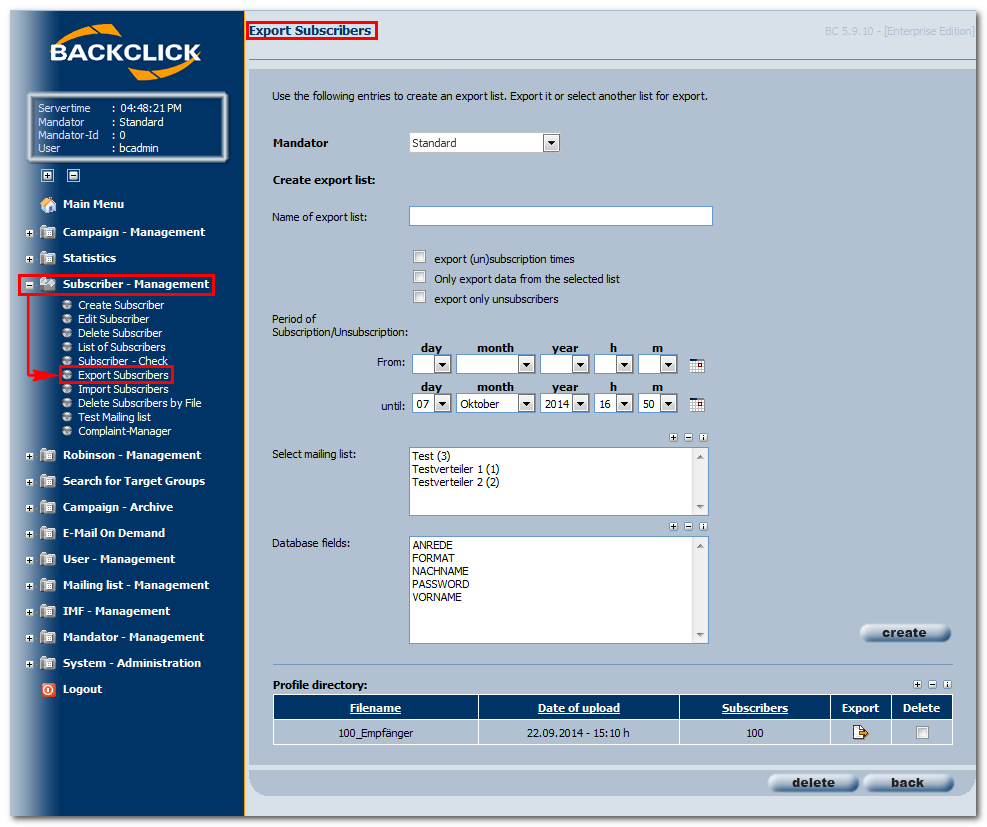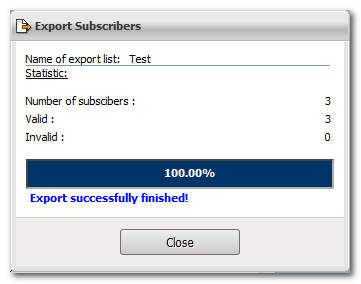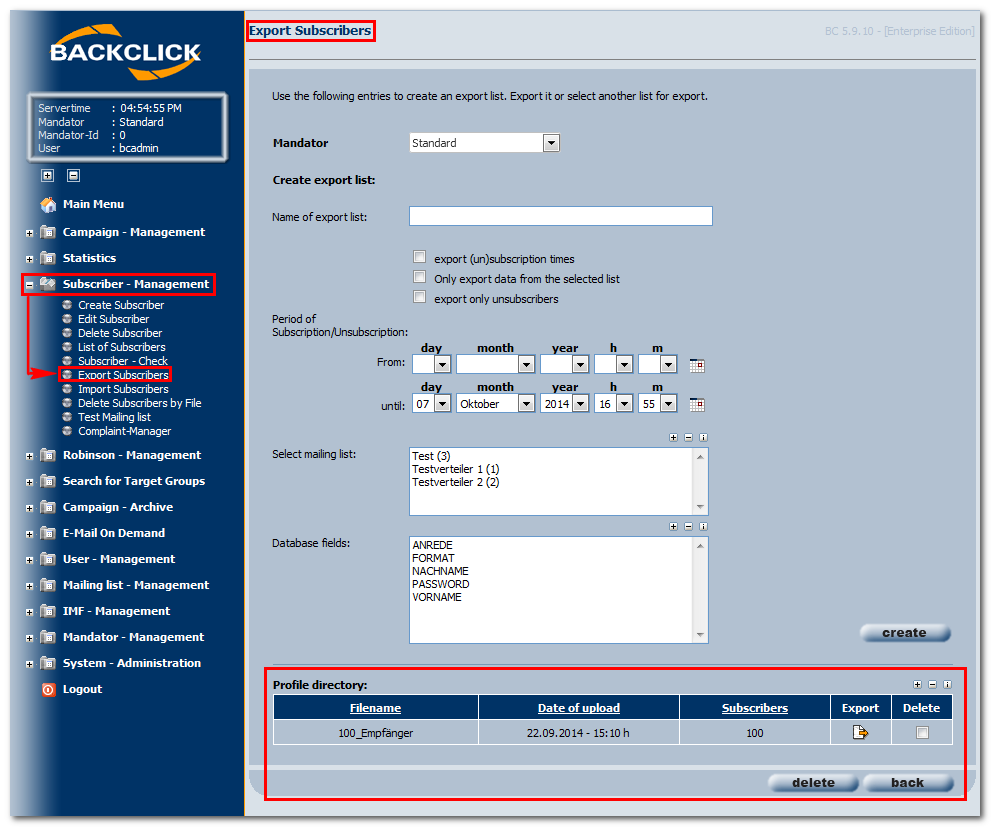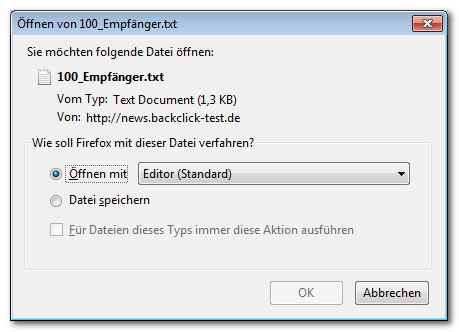Exporting subscribers’ data
The subscribers’ data may also be routinely used away from BACKCLICK. To export the subscribers’ data, choose “Subscriber Management (Main Menu) -> export subscriber” (submenu), and all of the existing data may be exported.
AbbOf course, you are able to use and edit data of your subscribers outside of BACKCLICK. Go to Subscriber - Management --> Export Subscribers in order to export existing subscriber data.
Fig. 7.5.1 - Abonnentenexport Export Subscribers
Name of
theexport list
of exportsEnter Choose a name for the export-file you want to create here. There is no need You don't have to define the file ending as “.csv,” “.txt,” etc..
Check boxes
Here you may decide which data you want to export. The subscription/ checkout data, data on mailing lists, or the checkout data only may be selected by marking the correct check box. You may also choose the subscription data as well as the checkout data of every subscriber. This is only possible after you have chosen “Subscription/ checkout data” and “checkout data”This defines data to be exported. Options are: "export (un)subscription times", "Only export data from the selected list" and "export only unsubscribers". Tick the corresponding check-box in order to receive this data.
When using "export (un)subscription times" or "export only unsubscribers" you are able to limit results to a specifc time of subscription and/or unsubscription. The export file will then contain two more additional columns in this case:
- SUBSCRIBED-x
- UNSUBSCRIBED-x
The “x” is a placeholder that stands for the consecutively numbered corresponding mailing list IDs. It is also possible to export only special data from the chosen lists. For example: There are subscribers in your system who are subscribed on mailing list 1 and 2, but you only want to export the information of mailing list 1. If this function is not activated, the data of mailing list 2 will also be exported because of these subscribers. The export file will then include a unix-timestamp-value.
Subscription/checkout data
If the ID.
Period of Subscription/Unsubscription
If data you want to export is about related to the subscription or checkout information of subscribers, you may choose time range for their subscription/checkout either period of subscription/unsubscription you are able to define this period. You may do this manually or by using the calendars .
Mailing lists
As shown in the figure, you may now calender provided ().
Select mailing list
This list shows all mailing lists you are permitted to access. You may choose one, more than one, or all of the mailing lists , if you have a right to them for exporting the subscribers’ data (multiple select field). After you have completed all the entries, click on in order to receive subscriber data to the corresponding list(s).
After you are happy with all settings, click the "create"-button. This You will open see the following view in a separate window:
As shown in the figure, the progress of the your export will be is shown during creation of the export file. Please click on the "close"-button for the first time AFTER the only AFTER your file has been created. The exportable file , ready for exporting, will then be listed under "Export directory".
AbbFig. 7.5.2 - Abonnentenexport Export Subscribers
This file will remain ready for exporting as long as it is saved in the system database. be available for export until you delete it.
As explained later on in this manualdocumentation, there may be other files , in addition to the your subscriber export files, that contain the results of the profile filter lists (target group list). These also may be saved on your local system. To export one of those files, click on the "Export"-symbol right behind the name of the file. This will open the following view:
Abb. Results of your target-group filter-exports are available for download as well. In order to export a file, click the -button next to the file you want to export. The following window will be shown:
Fig. 7.5.3 - Abonnentenexport Export Subscribers
A file download dialogue will be initiated. This will ask you to either open or save the file in your local system. To asking you whether you want to download or open the file will be displayed. In order to save the file, mark the check box that says “Save File,” and choose “Save File”, the file will automatically receive the ending “.txt”, allowing you to access it later on. If you would like the function to be processed whenever the file dialogue is opened, mark the check box that says, “For files of this type, always process this action.” Whenever a text file like this is exported, this action will be processed. want to use this option as default in the future, tick the check-box “Do this automatically for files like this from now on.”.
The file will be opened in an editor (per default value). The content of the Export-Test.txt file (in our example here) will then look looks like this:
All the fields are separated by tabs, which allows with tabulators, allowing you to use this file again for import importing purposes into BACKCLICK again.
To erase one of the export files, you must mark the check box right behind the name of the export file and click on the "Yes"-button. This will open another window displaying a safety question, which you will need to confirm by clicking on “yes” if you really want to erase the file. After this, the file will be removed from the list. PLEASE NOTE: Only the export file (the result of the export) will be removed, but not the subscribers. If you decide not to erase the file from your list when you see the window with the safety question, click on "No". This will return you to the submenu “export subscribers”.





